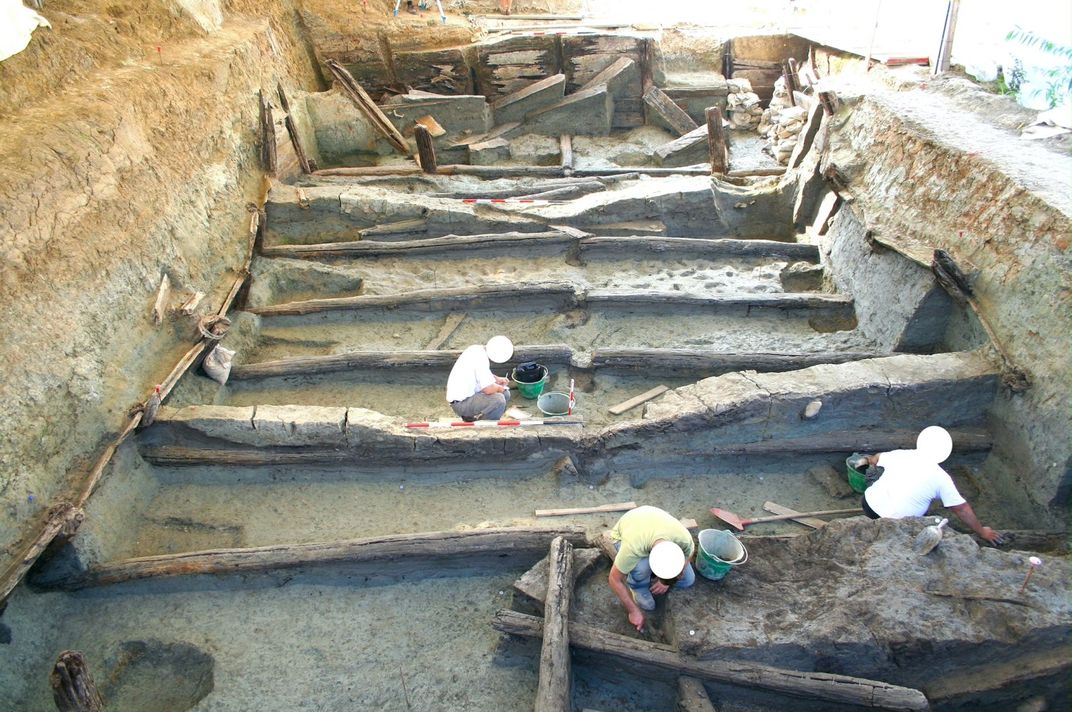3,400-Year-Old Artificial Pool in Italy May Have Hosted Religious Rituals
New research dates the wooden basin’s construction to a time of immense social change for Bronze Age people
:focal(591x352:592x353)/https://tf-cmsv2-smithsonianmag-media.s3.amazonaws.com/filer/b5/d8/b5d88481-f4bf-4f75-88b2-45a906387dd1/ritual_pool2.jpg)
An artificial pool built out of oak wood in what is now northern Italy likely hosted religious rituals some 3,400 years ago, during the Middle Bronze Age.
People constructed the in-ground, timber-lined pit—which measures about 40 feet long, 23 feet wide and 13 feet deep—at a location high on a remote hill, reports Agenzia Nazionale Stampa Associata (ANSA). The basin consists of one structure that appears to have collapsed before it was finished and a second built on top of the earlier one. Sediment in the pool shows that it was once filled with water. Given the pit’s location and the heavy timber required for construction, its installation must have been a laborious process.
Archaeologists first discovered the structure, known as the Noceto Vasca Votiva, or “votive tank,” in 2004. Now, researchers using a combination of radiocarbon dating and tree-ring analysis have determined when it was created. Per a paper published in the journal PLOS One, the pool’s lower tank was constructed in 1444 B.C., while the upper tank was built in 1432 B.C. The new research pinpoints the timing with just a four-year margin of error.
This finding means that ancient humans built the pool at a time of major societal change. Per Live Science’s Tom Metcalfe, the Terramare culture of the region, located along the Po Valley, became more socially complex during the mid-15th century B.C. Small farms were transforming into large settlements, and people were increasingly using plowing and irrigation to improve agricultural yields.
Study co-author Sturt Manning, an archaeologist at Cornell University, says evidence suggests that the pool was intended for ritual purposes. Its location means it was impractical as a source of water for local communities, and the absence of channels around it indicates it wasn’t used for irrigation. Instead, the pool’s elaborate construction—and the discovery of ceremonial pots and figurines inside of it—points to ritual use.
“As you would have come up to this thing, as soon as you’d been able to start to see the surface, you would have seen, effectively, the edge of the land around the sky,” Manning tells Live Science. “And as you got close to it, then you would have just been looking at the [reflected] sky—so you’d have, in a sense, entered another world.”

Manning notes that people often built labor-intensive ritual structures at times when new social and economic structures took hold.
“Nearly every time there’s a major change in social organization, there tends often to be an episode of building what might be described as unnecessary monuments,” he says in a statement. “So when you get the first states forming in Egypt, you get the pyramids. Stonehenge marks a major change in southern England.”
Live Science reports that ceremonial water features dating back as far as the 15th century B.C. have been found in other places, including Crete. But the pool is the only known structure of its kind in northern Europe.
Prior to the new study, researchers had only been able to estimate the origins of the pool to between 1600 and 1300 B.C. According to Daily Sabah, Manning and his colleagues reached their far more precise estimate using a technique called “wiggle-matching.” They matched patterns of radiocarbon isotopes from tree rings, which each correspond to a year of growth, with data from Germany, Ireland and North America. In addition to determining when the pool was made, they found that the structure was used for several decades before being abandoned for unknown reasons.
Though the gap between the two estimates “might not seem huge,” notes the statement, “in archaeological terms it’s like comparing the culture that invented the steam engine with the one that produced the iPad.”
The ritual purposes of the pool may have been related to the significance of water in the Po Valley, where people built extensive systems of dikes and terraces to irrigate crops. Manning tells Live Science that the pool was not part of those practical watering systems but adds that people may have used it to appeal to deities responsible for water and rainfall.
“It’s more about some group activity that they think is going to be beneficial,” he says, “or that the gods are going to be pleased that they have done this.”
/https://tf-cmsv2-smithsonianmag-media.s3.amazonaws.com/accounts/headshot/Livia_lg_thumbnail.png)
/https://tf-cmsv2-smithsonianmag-media.s3.amazonaws.com/accounts/headshot/Livia_lg_thumbnail.png)